It is now possible to put forward the main elements of the refugees' return plan.
1-Locating the Refugees
The Palestinian people are a very closely-knit family. Geographical dispersion in exile did not destroy the essential fabric of the society. They still marry within their own social circles, as they were in 1948-Palestine, although travel and residence in foreign countries have eroded this practice only marginally. This however has a positive effect as the foreign spouses have been drawn into the Palestinian circle. In general, there does not seem to be a serious problem in locating and identifying Palestinian families.
This family bond is important, especially for the Palestinian refugees who were not registered by UNRWA in 1950 or any time thereafter. The unregistered refugees are essentially the inhabitants of Palestinian cities who either left early in 1948, did not have a material need for assistance, which was the object of registration, or others who, while needy, did not register out of pride, prior to closing down of the registration process, or who missed the registration for one reason or another.
Careful estimates show that all refugees from 531 depopulated towns and villages by Israeli forces in 1948 are 4,940,000 as at the end of 1998, fifty years after al Nakba of 1948. Of those, 3,602,000 are registered with UNRWA.
Total refugees may be divided as follows [Fig-14]: 56% are registered refugees.
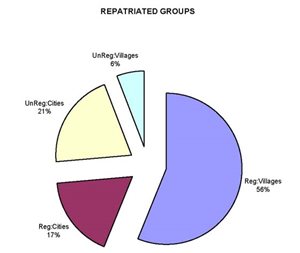 Fig-14: The Distribution of Refugees as per Registration and Origin. villages are 62% of total. Registered refugees are 73% of total.
Fig-14: The Distribution of Refugees as per Registration and Origin. villages are 62% of total. Registered refugees are 73% of total.
from villages; they have the highest percentage of registration and they lost all livelihood by losing their homes, farms and cattle. Therefore it is not surprising that only 6% of villagers are unregistered. The total is 62% or about two-thirds of all refugees representing rural areas. The remaining 38% are urban population. More than half of those (21%) are unregistered, leaving 17% registered. If we take the registered refugees only, we find that 23% are urban and 77% are rural, showing again that the majority of rural refugees are registered.
It should be noted that refugees were expelled, not only from 531 towns and primary villages, but also from 662 secondary villages, such as hamlets, satellites or small settlements.
There is no record of any Arab people in the Middle East as detailed and monitored over 50 years as that of the Palestinian refugees. At the time of registration, refugees had to show proof of residence in Palestine, e.g. Kushan (property title deed), passport, identity card, tax receipt, school certificate, government employment record… etc.
There are now over 700,000 family files and about 4 million individual files held by UNRWA. The following is listed: full name (including father, grandfather and family), sex, date of birth, place of origin (depopulated village), district, rank and relationship within the family (48 categories), number of family members and place of refuge. The latter is divided into 5 areas in which UNRWA operates: Gaza Strip, West Bank, Jordan, Syria and Lebanon. In turn, these areas are divided into regions and those into distribution centres. Every refugee has a unique number. It is possible to mobilize the people of any given village in a week.
Indeed, when the inhabitants of a village were expelled by the Israelis in 1948, they left en masse. Fully 72% of all the registered refugees moved to only one of the 5 UNRWA areas and 20% moved to two related areas of the five and only 8% moved to more than three areas.
Thus locating the refugees poses no problem.
2- Locating the Refugees' Land
The British Mandatory government in Palestine (1920-1948) documented the country in a series of detailed maps. This has served to preserve the Palestinian property rights, although the intention of the pro-Zionist government was the opposite, to facilitate Jewish immigration and settlement in Palestine by transferring to Jews as much land as possible.
In spite of persistent efforts, the Zionists did not have under their possession in 1948 more than 1,682,000 dunums or 6% of Palestine. This figure, which is the upper limit of land under Jewish possession, consists of:
| Full Possession |
1,449,958 dunums |
| Undivided share in a Common |
56,628 dunums |
| British Concessions |
175,000 dunums |
Not all the land under ‘full possession’ above was legally registered in the Land Registry. A considerable portion of this land was held or cultivated by the Jews on the basis of interim agreements, promises to sell, doubtful claims or in contravention with the Mandate Land Regulations. The fortnightly reports of the District Commissioners are replete with examples of fraud, unfounded or illegal claims. In Beer Sheba District, for example, the areas claimed by the Jews and included in the above summary are greatly exaggerated as evidenced by the District Commissioner’s report.
Much land is cultivated in Palestine as common village land (Musha’) which cannot be divided by shareholders, who are traditionally family members. When the Jews bought the share of one family member, they could not identify or split this share physically, much the same like a share on the stock exchange. Thus the Jewish ownership of undivided land remains an economic, not a physical, proposition.
The pro-Zionist Mandate government granted concessions to the Jewish colonists which had a given purpose and a maturity date, after which the land reverts back to the people of the land at the time. All concessions expired in 1948, when the British Mandate was dissolved on 15 May 1948.
Thus the figure for Jewish property in Palestine, small as it is, represents the upper limit of Jewish possession. Further, legal Jewish purchases are well documented as the great majority of such land was owned by colonial enterprises, not individuals, who kept records of transactions and ownership.
Be that as it may, it is clear that the remainder of Palestine is (non-Jewish) Palestinian property for countless generations. Palestinians should not be required to prove evidence, much as any region in England does not require proof of being British. The onus of proof of ownership lies with the foreign immigrants who wanted to secure a foothold in the country.
The UN, in its well-known resolution 194, formed the Conciliation Commission of Palestine (CCP). One of the lasting benefits of CCP is the documentation of Palestinian property in Palestine from the Mandate records and in consultation with Israel, Jordan and other Arab countries.
CCP recorded the ownership of about 500,000 Palestinian landowners, whose ownership covers an area of 5,194,091 dunums, classified under each of the administrative boundaries of towns and villages. The survey covered 797,504 parcels of land, which are well-defined on maps. Although these records are extremely valuable, they do not cover the whole extent of Arab Palestine. This deficiency is clearly seen by comparing the official area of each district with the total ownership (Jewish and Palestinian) of all lands in the district. Considerable deficiency of ownership according to CCP records is found in the sub-districts of Gaza, Hebron, Jaffa, Jenin, Jerusalem, Ramle and Tulkarm. CCP admits lack of information in Ramle sub district and in Jerusalem villages. More significantly, CCP omitted the entire Beer Sheba sub-district (12,577,000 d.) due to ‘lack of information’.
With the detailed British maps and the Land Registry records, and by subtracting authentic Jewish ownership records from the area of Palestine, the property of the Palestinian refugees is determined. Individual owners in each village/town are determined from CCP records. Village land is determined from administrative maps of Palestine which define the village boundary and area (according to Village Statistics of 1945). The village inhabitants are determined from UNRWA records. Thus the village land area, location and boundary, together with the names, number and present place of refuge of its owners (usually limited to 3-4 hamulas or extended families) are all satisfactorily determined.
3-Transfer of Ownership
The fictitious legal web created by Israel (see Section-4 above) has the unexpected advantage of making it easier for the Palestinians to restore the ownership of their property. All their land is administered by Israel Land Administration (ILA) which disposes of their property. No Jew holds a legal title deed to a Palestinian property. There will be no possibility of a multitude of legal disputes among Palestinian and Jewish individuals.
A simple way to deal with this situation is to transfer all legal jurisdiction from ILA to the proposed Palestine Land Commission (PLC). PLC will be created as an independent body to represent, defend and preserve material property rights of the Palestinians. Its members are representatives of 531 depopulated and dispossessed Palestinian towns and villages. As indicated earlier, the family unit in Palestine is very strong. Hence the village unit (and neighbourhoods in towns) can be regarded as stable building blocs of Palestinian society.
PLC will be the custodian for all property until individual owners are identified and verified. PLC will hold and acquire the property of those few who wish to dispose of it.
This system has many advantages. There will be a single transfer document form ILA to PLC. The records of ILA in its central and district offices contain electronic information of all Palestinian property in addition to maps showing parcels’ locations (with their British and new Israeli numbers) which are largely digitized with proper geographical coordinates under GIS.
The ownership of each village is well-defined in area and location in British maps. While the population of each village has increased more than 5 times in the last 50 years, the ownership of each family remains intact. Any dispute over ownership will remain essentially a family business.
Thus a smooth transfer is possible. Problems or disputes which may inevitably arise are transferred to PLC and, in turn, to village families.
4-Phases of Return
Due to the nature of repatriated groups, it is possible to split repatriation into 7 phases, each with a population varying between 0.5 and 1.0 million. See [Table-1].
Some phases could be concurrent. The whole process could take less than 10 years. These phases are:
-
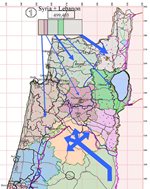 Fig-15: Return of Registered Village Refugees from Syria and Lebanon: Their return to Galilee poses no problem whatsoever. They will be united with their relatives left behind (Present Israeli towns with population over 20,000 are shown in circles proportional to size).
Fig-15: Return of Registered Village Refugees from Syria and Lebanon: Their return to Galilee poses no problem whatsoever. They will be united with their relatives left behind (Present Israeli towns with population over 20,000 are shown in circles proportional to size).
-
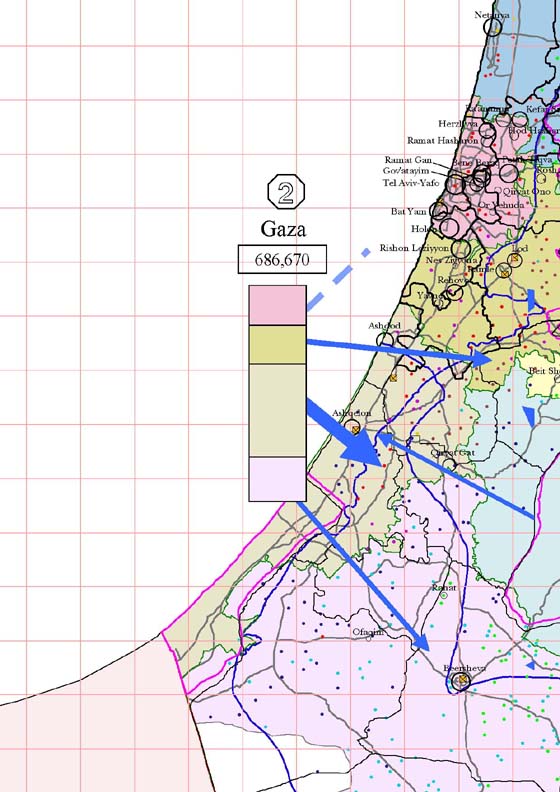 Fig-16: Return of Registered Village Refugees from Gaza Strip: Their return to various districts of origin in the south poses no problem except around Jaffa. (Present 'Israeli' towns with population over 20,000 are shown in circles proportional to size).
Fig-16: Return of Registered Village Refugees from Gaza Strip: Their return to various districts of origin in the south poses no problem except around Jaffa. (Present 'Israeli' towns with population over 20,000 are shown in circles proportional to size).
4.1-Return of Refugees from Syria and Lebanon. (Fig-15)
Their rounded-off number is 500,000, which represents the registered villagers from the districts of Haifa, Acre, Tiberias, Safad and Nazareth–excluding cities. All these refugees can return safely to their vacant village sites. There are only few affected villages (Table-1), where their village sites have been partially or fully built-over, as they are situated in the Area-A, which has the highest Jewish concentration. There are only two such villages, which are both in Area-A and fully built-over. These are: Tira, Wa’arat es Saris in Haifa district.
In general, these refugees will return to a friendly environment. They will be reunited with their long-separated kith and kin in Galilee, which is still largely Palestinian today.
4.2-Return of Refugees from Gaza Strip. (Fig-16)
Gaza Strip is the most crowded (about 6,000 persons/sq. km) and economically impoverished place; that is where the refugees from southern Palestine are crammed. Across the barbed wire, they can see their fields empty (at only 6 persons/sq. km). The rounded-off number of the registered refugees from villages in Beer Sheba, Gaza, Ramle and Jaffa districts is 686,000. The return to Beer Sheba and Gaza districts is straightforward, as their land is almost empty. As Table-1 shows, Qiryat Gat has expanded to cover the location of Iraq Al Manshiya houses, but the village land is still available. (The US Computer Company, Intel, has illegally built a plant on the location of the village houses).
Ramle refugees can return to their villages in the district, which is situated in Areas A, B, and C. Higher Jewish density in Area-A causes 2 villages to be affected: Aqir and Wadi Hunayn, and in Area-B 3 villages are affected: Sarafand al Kharab, Al Burj, Jindas. Jaffa villages need a special treatment.
4.3-Return of Registered Village Refugees from the West Bank. [Fig-17]
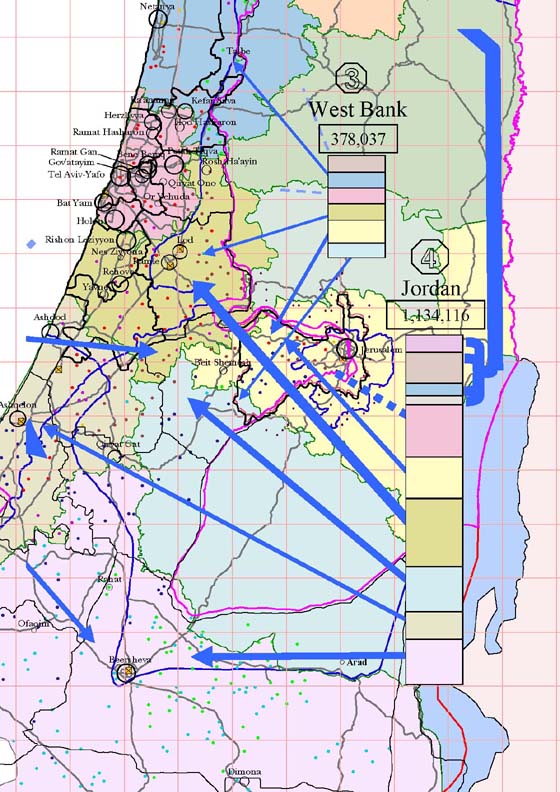 Fig-17: Return of Registered Village Refugees from West Bank and Jordan: The composition of the refugees in the West Bank and Jordan is the same. They can return to their original villages without difficulty except for some areas in the districts of Jaffa, Jerusalem and Ramla (Present 'Israeli' towns with population over 20,000 are shown in circles proportional to size).
Fig-17: Return of Registered Village Refugees from West Bank and Jordan: The composition of the refugees in the West Bank and Jordan is the same. They can return to their original villages without difficulty except for some areas in the districts of Jaffa, Jerusalem and Ramla (Present 'Israeli' towns with population over 20,000 are shown in circles proportional to size).
The rounded-off number of registered village refugees now living in the West Bank is 378,000. Their original homes are diverse (9 districts). They come from nearby Jenin, Jerusalem, Tulkarm and Hebron districts, from Gaza and Beer Sheba districts in the south, from Jaffa and Ramle districts in the centre, and from Haifa in the north. The number of refugees from each district is relatively small, ranging from a maximum of 71,000 from Jerusalem district down to 14,000 and 16,000 from Beer Sheba and Gaza districts respectively.
As indicated above, there is no problem in returning to vacant village sites in Gaza, Beer Sheba districts. Also, there is no problem in returning to Jerusalem district except for 5 villages: Lifta, Deir Yassin, Maliha, Ein Karem and al Jura, which are incorporated in greater Jerusalem. The subject of Jerusalem city deserves a special treatment which is excluded from this study.
Return to Haifa district is already covered in Section-12.4.1. Return to Jenin district poses no problem but Tulkarm district does. Eight villages fall within the coastal strip, which is densely populated by Jews and many of their sites are over-built. These are: Um Khalid (Netanya extended over its land), Khirbet Beit Lid, Wadi Qabbani, Biyarat Hanun, Ghabet Kafr Sur, Tabsur, Kafr Saba (next to Kefar Sava) and Khirbet al Manshiya. These are small villages. Their total present (1998) population is 19,000. Treatment of all such affected villages shall follow.
4.4-Return of Registered Village Refugees from Jordan [Fig-17]
This group is by far the largest, at 1,134,000. Their composition is similar to refugees in the West Bank with the addition of 3 new districts: Tiberias, Beisan (close to river Jordan) and Nazareth. The reason for their large number and the relatively small number of refugees in the West Bank is due to the 1967 war. Today the number of displaced persons as a result of the 1967 war is estimated to be 800,000 persons, who were expelled or forced to leave Palestine to Jordan. (The figure of 800,000 includes refugees and citizens of the West Bank).
The feasibility of their return is similar to those of the West Bank (12.4.3). The village sites in the new districts: Tiberias, Beisan and Nazareth are all vacant. However, a hamlet, al Manara, is built over by the expansion of Tiberias city. Nazareth district and part of Tiberias and Beisan districts are today inhabited by a sizeable Palestinian population.
4.5-Cities:
The previous phases refer to the registered refugees from villages only. The great majority of village sites are still vacant. Many of the village houses were destroyed by the Israelis. According to a field survey in 1987-1990, out of 407 villages surveyed, 81 villages were completely obliterated, 140 destroyed but rubble identified, 60 demolished with standing walls, 74 most houses demolished but some remain standing, 17 villages with many houses demolished and where 1-2 Jewish families live and 35 villages with houses standing where more than 2 Jewish families live.
The situation in the cities is different. No large scale demolition took place, but the remaining Palestinian inhabitants were not allowed to repair their houses, even to fix a glass pane, or to add an extra family room. Houses of evicted Palestinians were occupied by Jewish immigrants who were allowed to make all desired alterations.
In all, the Israelis conquered 14 Palestinian cities [Table-3]. These may be grouped.
as follows: 2 cities: Nazareth and Shafa Amr are still Palestinian. The return of the refugees there will not represent a problem. Six cities were entirely Palestinian: Safad, Tiberias, Beisan, Beer Sheba, Al Majdal (Ashqelon) and Isdud, except that Safad and Tiberias had a small old-time Jewish religious community. Those six cities (termed thereafter Group-2, G2) are now inhabited entirely by Jews, a clear case of ethnic cleansing. In the following phases we shall examine the possibilities of return to these cities.
The remaining 6 cities, (termed thereafter Group-1, G1) have special characteristics. Many of them are coastal; all have had always mixed Jewish and Palestinian population with the difference that, before 1948, Palestinians were a majority, now Jews are the majority. These are: Acre, Haifa, Jaffa, Lydda, Ramle and Jerusalem. Of all the 14 cities, there should be no insurmountable problem in the return of refugees to their homes, except for two: Jaffa, which lies in the middle of Jewish concentration in Palestine and Jerusalem, not so located but has a highly sensitive political and religious significance.
4.6-The Return of Registered and Unregistered City Refugees (Group-2)
The number of registered city refugees in Safad, Tiberias, Beisan, Beer Sheba, Majdal and Isdud is about 182,000. Here, those unregistered are much smaller than the case for larger cities. Their number is 78,000. For the sake of completeness, we add to this phase the unregistered village refugees, who did not, or were unable to register for reasons cited. Their number is 280,000; they pose no problem as they all come from empty or vacant sites. Thus the total number of refugees for this phase is 540,000.
It is now necessary to examine the town plan of each city. This is done using (1) British Mandate town planning maps showing the built-up areas, town planning urban limit and the town’s rural land and (2) the built-up area of the city according to modern Israeli maps (year 1998) showing the extent of the present urban area. In order to compare 1948 and 1998 areas, Palestinian town’s area of 1948 is expanded, in the space available now, to reflect the present Palestinian population had they not been evicted. This is shown (in purple) in all diagrams of cities, together with 1948 (Palestinian) and 1998 (Israeli) urban limits.
The results are shown in [Figs-18, 19, 20, 21, 22, 23] In all cases, it is shown
-
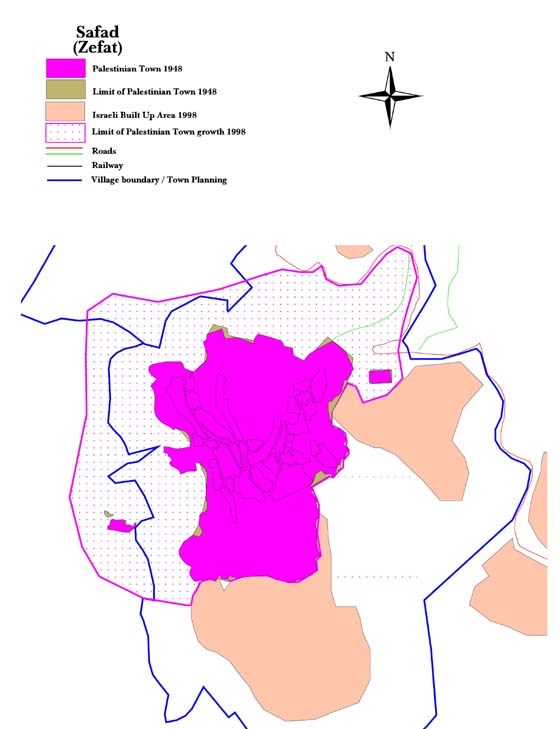 Fig-18: Safad, Past, Present and Future.
Fig-18: Safad, Past, Present and Future.
-
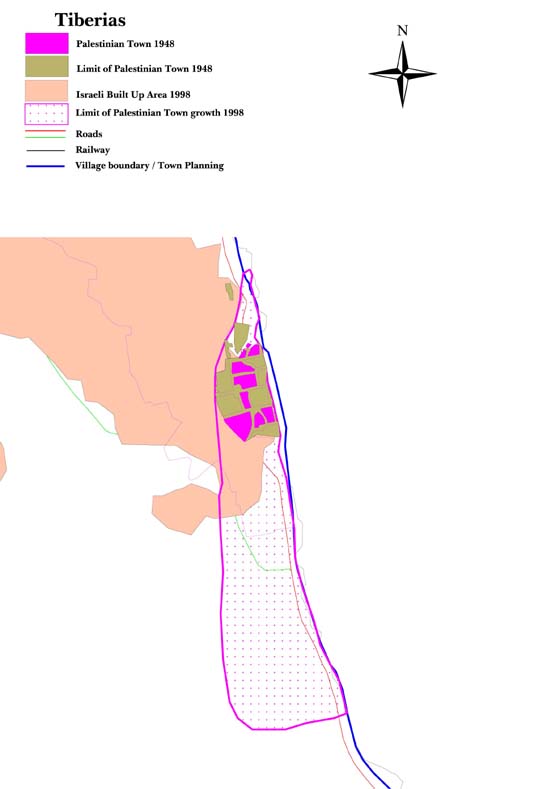 Fig-19: Tiberias, Past, Present and Future.
Fig-19: Tiberias, Past, Present and Future.
-
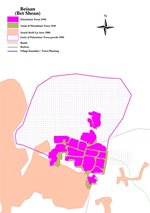 Fig-20: Beisan, Past, Present and Future.
Fig-20: Beisan, Past, Present and Future.
-
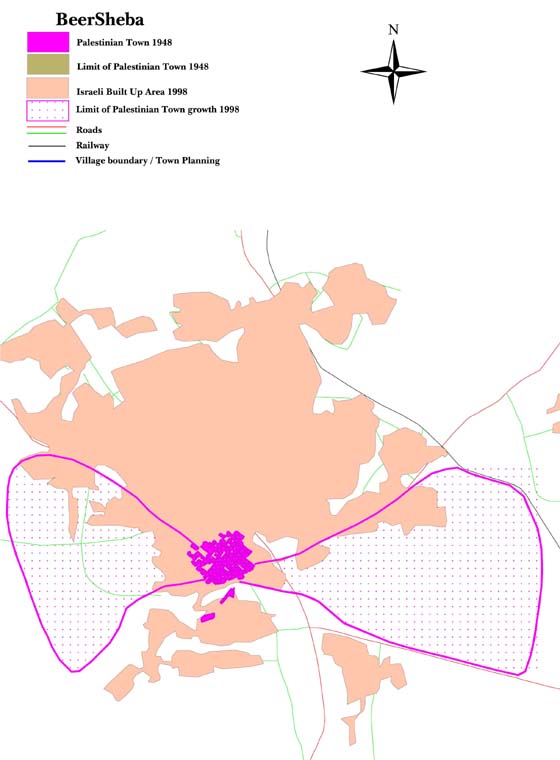 Fig-21:Beer Sheba, Past, Present and Future.
Fig-21:Beer Sheba, Past, Present and Future.
-
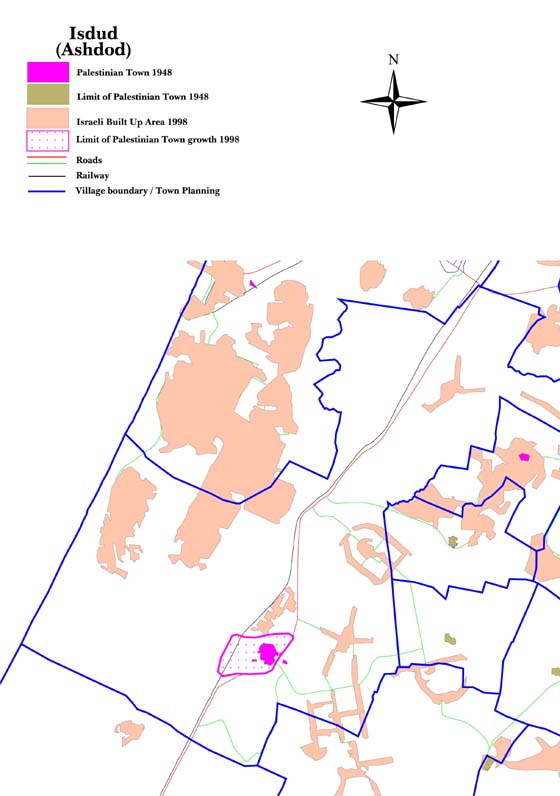 Fig-22: Isdud, Past, Present and Future.
Fig-22: Isdud, Past, Present and Future.
-
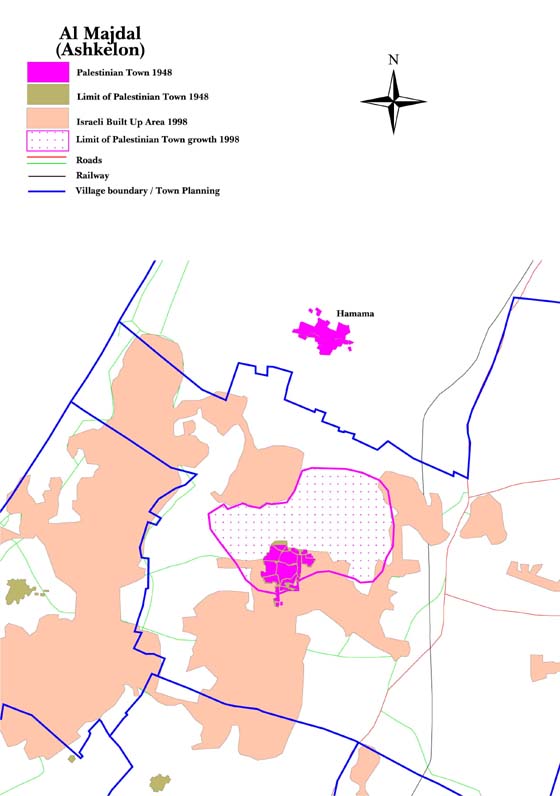 Fig-23: Al Majdal, Past, Present and Future.
Fig-23: Al Majdal, Past, Present and Future.
that Palestinians can return to their cities and can build new homes, for the increased population, in the city land without necessarily evicting the present Jewish occupants as done by Israel to the Palestinians in 1948.
In Safad, the city can expand to the north and east to accommodate the returnees. In Tiberias, the expansion can take place along the shoreline of the lake. In Beisan, there is plenty of space for expansion in all directions except the south. Beer Sheba has expanded greatly, mostly to the north, leaving east and west and possibly the south for new expansion to accommodate the returning home owners.
Isdud does not present a problem at all. The city can expand around its original position, which was a large village. The new Israeli Isdud (Ashdod) is built elsewhere, on the shoreline where a large port is built.
Al Majdal can expand in all directions except the south. Again the new Majdal (Ashqelon) is built on the shoreline.
It is significant to note that all of the six cities are now inhabited by non-Ashkenazi Jews. As such, they do not benefit from the favours showered on the Ashkenazi ruling elite. They suffer from discrimination and are economically impoverished, but less so for Isdud due to the port activity and Beer Sheba where the university provides large employment.
With the dismantling of Israel’s racist policies, and the removal of Zionist incitement to Arab hatred, it is possible for the Palestinian returnees to live in harmony with the present Jewish inhabitants who are mostly Mizrahi, that is Jews from Arab and Islamic countries.
4.7-The Return of the Registered City Refugees (Group-1)
This phase refers to the return of 653,000 refugees back to the cities of Acre, Haifa, Jaffa, Lydda, Ramle and West Jerusalem (Group-1). Their return is often mentioned as a symbol for the return of all refugees. The Palestinian demonstrations, petitions and political statements often refer to the return to “Jaffa and Haifa”. The Israelis respond with ready-made answers and programmed fear: “This will dismantle Israel”. This symbolism refers however to a particular case and a small number of refugees. Even so, closer examination gives a more realistic picture.
First, it must be recognized that Palestinians do now live in the cities of Group-1. More than 80,500 Palestinians live in 5 cities of Group-1 excluding (West) Jerusalem, out of a total of 173,400 Palestinians in all of the 14 Palestinian cities. (This study is concerned with all territories occupied by Israel in 1948 and bounded by the inner line of the Armistice Agreement of 1949. It thus includes West Jerusalem in which no Palestinians live today).
Acre and Haifa [Fig-24, 25] are known to enjoy relatively peaceful coexistence.
-
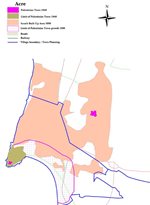 Fig-24: Acre, Past, Present and Future.
Fig-24: Acre, Past, Present and Future.
-
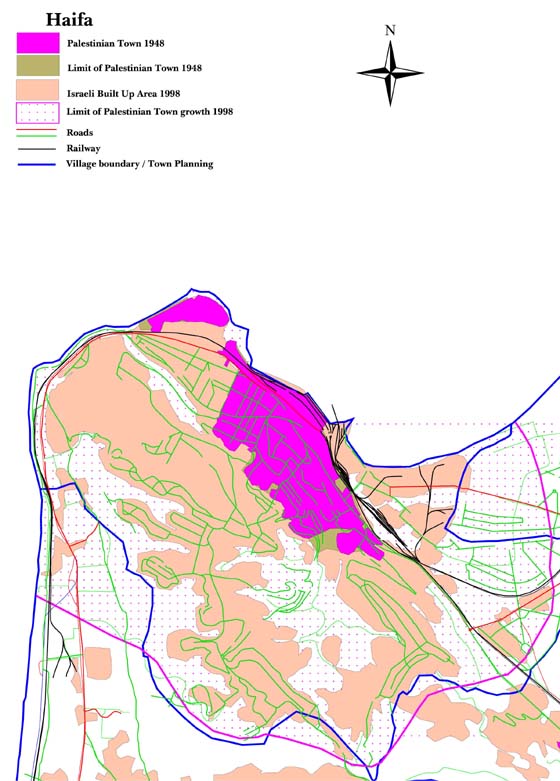 Fig-25: Haifa, Past, Present and Future.
Fig-25: Haifa, Past, Present and Future.
between Palestinians and Jews. The Palestinians still live in the Old City of Acre and the returnees can expand this city along the shoreline, still within Acre lands. Haifa’s Palestinian population are an active element in the society. They still live in large concentrations in old Haifa particularly Wadi Nisnass, Abbas, Carmel and old city. But metropolitan Haifa has still large vacant spaces to the south and east, sufficient to accommodate the new comers.
Lydda and Ramle, which were once a proud, rich and vibrant twin, have now been reduced to a lamentable state of decay. The decay is both urban, out of neglect and biased administration, and moral; they are the centre of drug trade. Palestinians there suffer from economic deprivation and social incohesion. New Jewish immigrants are sent there; they desert the place as soon as they know the country better. It is to them a ma’abarot, a transit centre.
With the return of the original homeowners, they can bring back lustre and dynamism to these cities, especially with the return of well-known merchant families, writers and artists back to their cities.
As [Fig-26] shows, the amalgamation of the twin cities is inevitable. The expansion of the two cities to accommodate the returnees is quite possible. In addition to their famed agriculture, their location, astride railway and road junctions, will bring affluence to the now decaying cities by virtue of the energies of its returning merchants.
The return to Jaffa [Fig-27] is a difficult but not unsolvable problem. The reason is..
-
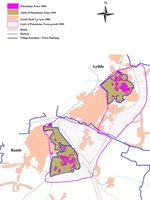 Fig-26: Lydda and Ramla, Past, Present and Future.
Fig-26: Lydda and Ramla, Past, Present and Future.
-
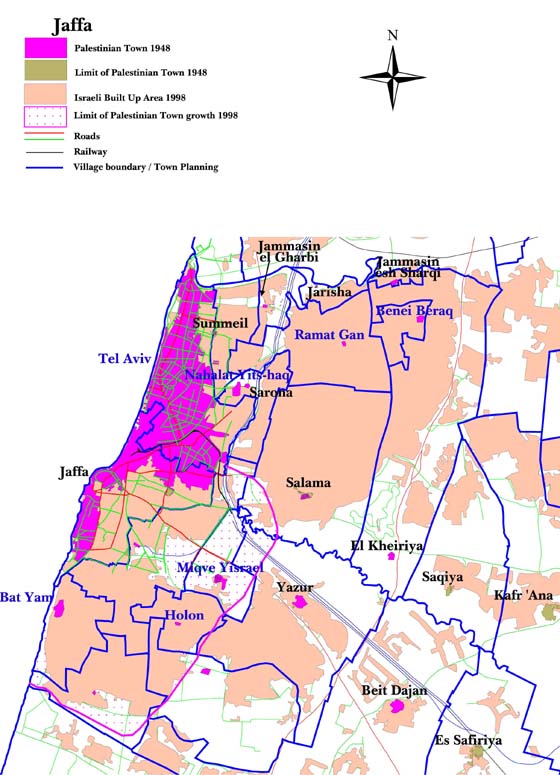 Fig-27: Jaffa, Past, Present and Future.
Fig-27: Jaffa, Past, Present and Future.
that Jaffa is surrounded by heavy Jewish concentration of all sides, leaving it open only to the sea. The southern settlements of Bat Yam and Holon have encroached upon Jaffa (rural) land, reducing its capacity for expansion. With significant numbers of Palestinians still in Ajami, new neighbourhoods have been built in eastern Jaffa lands, which were largely planted with orange groves, stretching from Saknet Abu Kabir through Saknet Darwish to ‘Arab Village’ in the south. These are now called Jaffa central, Jaffa alef, dalet, gimel. The population there is thoroughly mixed. With high rise construction, as in neighbouring Tel Aviv, it is possible to accommodate 100,000 families in about 3 sq. km. This requires both good planning and good neighbourly relations.
Jerusalem is, and will always be, a special case. Almost all Jerusalem land (urban and rural) have been built-over. Jerusalem should be the subject of a detailed separate study.
4.8-The Return of Unregistered City Refugees (Group-1)
This last phase of repatriation involves 900,000 unregistered refugees from the six major Palestinian cities. Today they hold important financial and governmental positions in Amman, Beirut, the Gulf, London and Washington. They are the most mobile, affluent and sophisticated segment of the society, but unlike 1948, their political influence in Palestinian affairs today is minimal.
Their return, in terms of housing, would pose the same problems as that of the registered refugees, although they possess much more property. The size of their holdings, together with their business experience and contacts will add vitality to the economic life of the cities.
5-The Restitution of Village and City Property
It has been shown that most of the village sites are vacant and the refugees could return to their homes without difficulty. As [Table-3] shows, only 57 villages, out of
531 towns and villages are affected in a way or another, by the encroachment of Jewish urban expansion. The present exiled population of these villages is 414,000, or about 10% of all registered refugees. This means that fully 90% of the refuges can return home without difficulty.
The picture is even brighter than this. It is considered that the problem area is related to villages (1) which falls in Area A, with high Jewish density and (2) where its site is fully built-over. This applies only to 24 villages, 5% of all villages. Their present population is 160,000, or 4% of registered refugees (3% of all refugees), which is a tiny minority.
The largest number of highly affected villages lies naturally in the coastal strip where there is highest Jewish concentration in and around Tel Aviv. This includes villages such as Salama, Sarona, Summeil (Mas’udiya), Jarisha, Jammasin Gharbi and Sharqi, Yazur, Beit Dajan and Sheikh Muannis on which Tel Aviv university is built.
Affected villages near West Jerusalem are Lifta, Deir Yassin, al Jura and Maliha (on whose land the notorious Gilo settlement is built).
All Jewish-occupied Palestinian property in all cities can be dealt with smoothly.
For all these cases: the affected villages and cities, the ownership is transferred first from ILA to PLC, then it is handed over by PLC to eligible and qualified property-owners. Those owners then extend the existing lease of the Jewish occupant, if he wishes so, to a period depending on the owner’s family requirements but not less than 3 years. The owner may elect meanwhile to build a house in another location, until his property becomes free. Funds for this construction come from the compensation due, including the revenue of the property for the last 53 years in accordance with UN resolutions.
For all other villages (over 90%), the procedure is straightforward. Villagers take possession of their land directly, unless some elect to continue the lease of some of their land for agricultural uses. The problems of this transaction are minimal, given the reasons cited above about the Kibbutz agriculture.
6-Sequence of Homes Construction
The previously outlined 7 phases are meant to describe the categories of returnees according to whether they are registered or unregistered, whether city or village refugees, and according to their place of refuge at present.
These phases do not imply time sequence. To create a time schedule, it is possible to identify the following ‘standard’ unit for housing construction to replace demolished villages:
| Number of returnees |
330,000 |
| Housing units required |
66,000 |
| Built-up area, m2 |
10.0 million |
| Number of months allowed |
12.0 |
| Labour required |
82,500 |
| Average village population |
5,000 |
| Average number of villages |
66 |
Using the above unit as a yardstick, construction for registered village refugees from Syria and Lebanon, (Phase 1), will take 1½ years, followed by registered village refugees from the West Bank, (Phase-3), which will take 1 year, followed by: registered and unregistered city refugees (G2) + unregistered village refugees, (Phase-5), which will take 1½ years, followed by: registered city refugees (G1), Phase-6, which will take 2 years. This makes a total of 6 years.
Simultaneously another construction activity could start with: registered village refugees from Gaza, (Phase-2), which will take 2 years, followed by registered village refugees from Jordan, (Phase-4), which will take 3½ years.
The remainder, i.e. the repatriation of unregistered city refugees of G1, could start following the conclusion of the two construction activities. The total period required is eight years. Allowing for various unforeseen obstacles, the whole process may take 10 years, in order to rebuild all houses or refurbish them.
This is of course is a rough estimate. It could be shorter because only villagers need new construction. It could also be longer to allow for natural increase during the ten years of repatriation (about 1.5 million).
The above two construction activities would require 165,000 construction workers for up to 10 years. Is this labour force available?
At present, the labour force in the Occupied Palestinian Territories (OPT = West Bank and Gaza) is about 20% of the population, including unemployed labour. This is well below the potential labour percentage of 38.7%. Taking the lower figure of 20% and taking into consideration that 25% of the labour is employed in construction, the available Palestinian construction labour force within all refugee population is about 250,000. Construction labour force in OPT (refugees and non-refugees) in 1998 was 142,000, of which about 70,000 work legally in Israel. It thus appears there is no shortage of labour for the repatriation process.
The Total cost of construction and infrastructure for full repatriation is in the order of $45 billion over a period of 10 years. This can be financed from the total compensation package to be paid by Israel to the refugees for 53 years of suffering, exploitation and destruction of property and for war crimes in accordance with resolution 194 and international law. Financial aid may be obtained from USA and Europe.
In the final analysis, it is possible to construct a financial package in which aid in kind, self-employment, advance payments for future projects can be incorporated. The result would be that the required cash outlay would be much less than the above figure.
As soon as repatriation becomes possible, advance parties from each village can take possession of their land and set up temporary centres and accommodation. As rehabilitation process proceeds, more refugees of the village can return home.
Already there are several examples in the Middle East for massive housing projects. In addition to Israel’s tenfold increase (through both natural increase and immigration) of its 1948 Jewish population of 600,000, we can cite the examples of Amman’s expansion (ten times), Beirut’s (six times), and Kuwait’s (thirty-three times), in which the Palestinian refugees themselves played a key role.
7-International Action
This plan for the refugees’ return may be considered logical and necessary, but it remains theoretical, unless the force of international law is brought to bear on the responsible party. The victims must be rescued from the injustice visited upon them by a far more superior military power. International law was implemented by big powers in Kuwait, East Timor, Kosovo and Bosnia. This could be done again in Palestine.
It is true that political expediency and strategic interests of the US, rather than concern for human rights, have been the major motivation for its international action. In this century, it is impossible to separate human rights from peace and stability, hence strategic interests of big powers. The world is becoming literally a global village. The overwhelming world-wide support for the Palestinians, excluding the US and some countries in Europe, cannot be ignored for long.
Europe, particularly, must take a leading role in initiating positive action. Not only because the Palestinians are made to foot the bill for the problem created in and by Europe, but because of the close geographical and economic connections between both sides of the Mediterranean.
There are already many examples of positive international action in Kosovo, Bosnia and East Timor. Not only was force used when necessary, measures were also taken to remove or reduce the obstacles preventing return. In the former Yogoslavia, the Committee on the Elimination of All Forms of Discrimination has recommended changes in domestic laws and regulations concerning naturalization, acquisition of citizenship, determination of refugee status and tenure to bring them in line with international law. When local authorities refused to reform or repeal discriminatory laws, the international community has, in Kosovo, unilaterally repealed laws that negatively impact the rights of the refugees.
Assuming that certain western powers cease to be an obstacle and join the rest of the world in enforcing international law, the following action may be taken:
The Security Council should act to implement Resolution-194, first passed in December 1948 and reaffirmed annually ever since, by all possible means at its disposal. The resolution should be implemented at “the earliest practicable date”, which has been suspended, due to Israel’s intransigence, from the original date of July 1949, the date of the last Armistice Agreement, till today.
The resolution entitles the refugees to return to their original homes, not to any other location, and in addition, to compensation for material and psychological damages and losses, including loss of revenue, in accordance with international law and legal precedents. War Crimes, which have been referred in Resolution-194 to a special court, shall be dealt with by the International Criminal Court, created by the Statute of Rome in July 1998.
After the implementation of the Right of Return, compensation procedure may be established as a separate but subsequent step. Compensation can never be a substitute for return. Homeland is not for sale.
Resolution-194 has already created the mechanism for implementing the return in the form of the Conciliation Commission for Palestine (CCP). Care should be exercised to avoid aborting its activities, as Ben Gurion did in 1949-1951. The mandate for CCP should be bolstered to deal with the present situation. CCP should be able to implement the Right of Return under the pain of sanctions (similar to the Iraq case), should set up a compensation agency (there are many applicable precedents), should take up the role of protecting the returnees physically and legally during the whole process of rehabilitation. This protection has not been spelled out clearly, as it should. The protection afforded by the UNHCR should be added to the CCP mandate. UNHCR has excluded the Palestinian refugees from its protection by virtue of clause 1D, due to the unique status of the Palestinian people. In a serious legal study, UNHCR mandate is shown to add protection to the refugees, not to diminish it.
The civil, religious and political rights of the returnees have already been clearly delineated in chapters (2) and (3) of Resolution-181 (II) of November 29, 1947. This should be incorporated in the CCP mandate to safeguard the returnees’ rights and prevent them from being victims of any kind of discrimination and apartheid practices.
With the return of the refugees, they must recover their nationality. According to international law, the people and territory go together. Whoever takes over the territory must also take the people.
UNRWA has a lot of work to do. With its 21,000 staff and its tremendous experience of providing uninterrupted service to the refugees, through 4 wars and innumerable raids and attacks, for the last 50 years, it has a unique standing. UNRWA should be expected to take care of all operations of rehabilitation. It should turn itself into a sort of UNDP, not only to build the infrastructure but also to create economy-building projects. Its mandate will last for 10 years from the first date of return, then tails off for another 10 years.
Considering the success of the international operations of rescue and rehabilitation after the Second World War and considering the enormity of the Palestinian refugees’ plight, it is imperative that the international community takes a firm stand. This is made possible because the Palestinian case has by far the most comprehensive legal groundwork and uniform international consensus. It has been the major occupation of the UN since its inception half a century ago. The UN can now act, with the long-denied support of western powers, to implement international law and bring permanent peace to the Middle East. This is befitting the largest, longest and most politically important refugee problem in the world.